Basque Recipe: Txuleta with Red Pepper

Txuleta (T-bone steak) with red pepper represents a long Basque culinary tradition of using the products and animals found in their local landscape to make hearty dishes. At the same time, it demonstrates their willingness to go beyond their borders for inspiration.
Betizu: Ancient Cattle
In Basque country, domesticated cattle are raised for their meat to use in dishes like txuleta.But during a cooking demonstration in the Folklife Festival’s Ostatua Kitchen, chefs Igor Ozamiz Goiriena and Igor Cantabrana explained the dish’s connection to the now endangered betizu cow.
The betizu is a breed of wild cattle native to the mountains of Basque country. Often red in color, it also goes by the names behigorri (red cow), zezengorri (red bull), and txahalgorri (red calf). It is the last remaining feral cattle breed in Europe, with only around 600 remaining in the wild. It is also one of the most ancient breeds of cattle.

While its exact origins are unknown, the betizu has a presence in ancient Basque mythology, where the cow was believed to be a spirit that guarded important caves. Some theories suggest that the betizu is a descendent of the ancient Basque or Pyrenean breeds of cattle. Another theory argues that the betizu is represented in the prehistoric cave paintings of the region, where there are depictions of bulls in reddish hues.
Traditionally, the betizu was used by the Basque people for its meat. Today the species is protected due to its endangered status, and beef comes from other domesticated breeds. But as long as the recipe is tied to the history, txuleta still connects the Basque people to the cuisine of their ancestors and the betizu.
Peppers: America’s Harvest in the Basque Kitchen
Peppers also play a central role in Basque gastronomy, but unlike the betizu, they are not autochthonous to Basque country. They came from the Americas after European contact and have been a key ingredient in Basque cuisine for over two hundred years.

Most peppers used in Basque cooking are sweet and mild—less spicy than their American counterparts. The sweet piquillo pepper served alongside txuleta has little to no spice. This mildness is due to the low levels of sunlight in the region that reduce capsaicin levels, the chemical responsible for spice. As a result of these low levels, Basque cuisine rarely uses spices. Instead, Basque cooks try to accentuate the natural flavors of traditional ingredients.
Txuleta with red peppers is no exception. It is a simple recipe that preserves the flavors of its basic ingredients.
Recipe: Txuleta with Roasted Red Peppers
(Makes 2-3 servings)
Ingredients
1 txuleta (T-bone steak) (a good cut will be around 2” thick and be able to stand on its side)
1 piquillo pepper (or alternatively any sweet, red pepper)
Salt
Olive oil
Preparation
Peppers

- Take a full red pepper and place it on a roasting stick. Using a burner with the plate removed, lay the pepper in the open flame. Roast the pepper until its skin is entirely black. Rotate as needed. Burning the skin makes the pepper easier to peel and gives it a slight barbeque flavor.
- Peel the pepper by gently scraping off the burnt parts with your fingers or a paper towel. Do not use water as the pepper will lose flavor.
- Chop or tear the pepper into long thin strips.
- In a 10” sauté pan, add a layer of olive oil (approximately 1/2 cup or 4 oz.) and the strips of pepper. Let the peppers cook in low heat for 5 minutes to soften.
- Serve once the meat is ready.
Txuleta

- Place the txuleta on a skillet or barbeque. Cook one side for approximately 4 to 5 minutes on low heat.
- Flip sides when the steak gets a nice browned color.
- Add a layer of salt on the top side. This helps keep the juices in and makes the meat crispier.
- Cook the second side for 4 to 5 minutes.
- Once done, shake off the excess salt.

6. Cut the meat off of the bone in long strips, cutting from the outside in toward the bone.
Note: The meat should still be red, rare to medium rare. Since it is warm, it will be okay to eat. The dish is traditionally served along with hot stones. The stones can be used to cook the meat further if desired.
7. Place the meat on a platter with the peppers and serve.

References
The Center for Basque Studies, “Race to save wild Basque cattle in Iparralde,” UNR.edu.
M. Gómez, J.M. Plazaola, and J.P. Seiliez, “The Betizu Cattle of the Basque country,” Animal Genetic Resources Ingormation 22 (1997).
Mark Kurlansky, The Basque History of the World (London: Random House, 2000).
Shanna Killeen is a Basque program intern for the Smithsonian Folklife Festival. She recently graduated with degrees in English and Spanish, and she is currently working on a master’s in English at Oregon State University.

